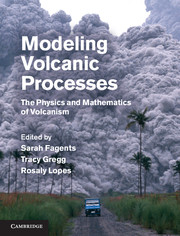Book contents
- Frontmatter
- Contents
- Contributors
- Chapter 1 Introduction
- Chapter 2 Magma chamber dynamics and thermodynamics
- Chapter 3 The dynamics of dike propagation
- Chapter 4 Dynamics of magma ascent in the volcanic conduit
- Chapter 5 Lava flows
- Chapter 6 Unsteady explosive activity
- Chapter 7 Unsteady explosive activity
- Chapter 8 Sustained explosive activity
- Chapter 9 Modeling tephra sedimentation from volcanic plumes
- Chapter 10 Pyroclastic density currents
- Chapter 11 Magma–water interactions
- Chapter 12 Deep-sea eruptions
- Chapter 13 Volcano–ice interactions
- Chapter 14 Modeling lahar behavior and hazards
- Chapter 15 Introduction to quantitative volcano seismology
- Chapter 16 Volcano acoustics
- Chapter 17 Planetary volcanism
- Index
- Plate section
- References
Chapter 2 - Magma chamber dynamics and thermodynamics
Published online by Cambridge University Press: 05 March 2013
- Frontmatter
- Contents
- Contributors
- Chapter 1 Introduction
- Chapter 2 Magma chamber dynamics and thermodynamics
- Chapter 3 The dynamics of dike propagation
- Chapter 4 Dynamics of magma ascent in the volcanic conduit
- Chapter 5 Lava flows
- Chapter 6 Unsteady explosive activity
- Chapter 7 Unsteady explosive activity
- Chapter 8 Sustained explosive activity
- Chapter 9 Modeling tephra sedimentation from volcanic plumes
- Chapter 10 Pyroclastic density currents
- Chapter 11 Magma–water interactions
- Chapter 12 Deep-sea eruptions
- Chapter 13 Volcano–ice interactions
- Chapter 14 Modeling lahar behavior and hazards
- Chapter 15 Introduction to quantitative volcano seismology
- Chapter 16 Volcano acoustics
- Chapter 17 Planetary volcanism
- Index
- Plate section
- References
Summary
Overview
Magma chambers are continuous bodies of magma in the crust where magma accumulates and differentiates. Both geophysical and geochemical techniques have illuminated many aspects of magma chambers since they were first proposed. In this chapter, we review these observations in the context of heat and mass transfer theory. This chapter reviews heat transfer calculations from magma chamber to the surrounding crust, and also considers the coupled stress fields that are generated and modified by the presence of magmatic systems. The fluid dynamics of magma chambers has received considerable attention over the last several decades and here we review the ramifications of convection in magma chambers. Multiphase flow (melt + crystals + bubbles) plays a particularly important role in the evolution of magma chambers. The large density differences between melt and discrete phases such as bubbles and crystals, and the resulting flow fields generated by buoyancy are shown to be an efficient mechanism to generate mixing in chamber systems. Finally we discuss integrative approaches between geophysics and geochemistry and future directions of research.
Introduction
The compositional diversity of melts that reach the surface of the Earth, and diversity in eruptive style, are largely determined through processing of these melts as they ascend and sometimes stall in the crust. Most eruptive products and intrusive suites have been modified substantially from their progenitor mantle magmas, either through preferential removal of crystal phases during fractionation, assimilation of crustal melts, or a combination of these processes (Daly, 1914; Anderson, 1976; Wyllie, 1977; Hildreth and Moorbath, 1988; DePaolo et al., 1992; Feeley et al., 2002). Much of the evolution of these magmas likely occurs where they spend the most time: where magma has either permanently or temporarily stalled in magma chambers. This accumulation is fundamental to the genesis of large eruptions, as the background flux from the mantle cannot explain the voluminous outbursts of magma at the surface of the Earth. Magma chamber dynamics largely control the compositional evolution of these magmas, and ultimately a better understanding of magma chambers may provide clues to the triggering of eruptions.
- Type
- Chapter
- Information
- Modeling Volcanic ProcessesThe Physics and Mathematics of Volcanism, pp. 5 - 31Publisher: Cambridge University PressPrint publication year: 2013
References
- 5
- Cited by



